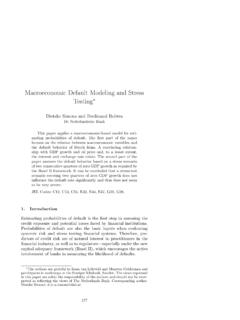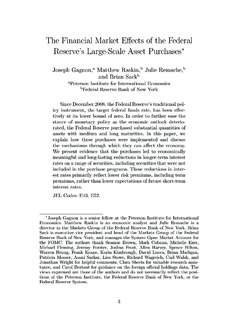Transcription of Granularity Adjustment for Regulatory Capital Assessment
1 Granularity Adjustment for RegulatoryCapital Assessment Michael B. Gordyaand Eva L utkebohmertbaFederal Reserve BoardbUniversity of FreiburgThe credit value-at-risk model underpinning the internalratings-based approach of Basel II and III assumes that idio-syncratic risk has been fully diversified in the portfolio, so thateconomic Capital depends only on systematic risk contribu-tions. We propose a simplegranularity Adjustment (GA) forapproximating the effect of undiversified idiosyncratic risk onrequired Capital . To mitigate operational burden in implemen-tation, we derive upper and lower bounds on the GA underincomplete information on the portfolio. We assess the mag-nitude and accuracy of the proposed GA on a set of bankportfolios drawn from the German credit Codes: G32, G28, IntroductionIn the portfolio risk-factor frameworks that underpin both indus-try models of credit value-at-risk (VaR) and the internal ratings-based (IRB) risk weights of Basel II and Basel III, credit risk in aportfolio arises from two sources, systematic risk and idiosyncratic This paper originally circulated under the title Granularity Adjustmentfor Basel II.
2 Much of this work was completed while M. Gordy was a visit-ing scholar at the Indian School of Business and while E. L utkebohmert was atthe Deutsche Bundesbank and University of Bonn. We thank Klaus D ullmann,Chris Finger, Christian Schmieder, Dirk Tasche, and Birgit Uhlenbrock for help-ful comments and input, and Jim Marrone for excellent research assistance. Theopinions expressed here are our own and do not reflect the views of the DeutscheBundesbank or of the Board of Governors of the Federal Reserve System. Authore-mails: and Journal of Central BankingSeptember 2013risk. Systematic risk arises because of unexpected changes in macro-economic conditions and financial market conditions to which mostborrowers are exposed. This risk cannot be eliminated through diver-sification across borrowers. All remaining sources of risk are idiosyn-cratic, , particular to individual borrowers. As a portfolio becomesmore fine grained, in the sense that the largest individual exposuresaccount for a smaller share of total portfolio exposure, idiosyncraticrisk is diversifiedaway at the portfolio the asymptotic framework that underpins the IRBapproach, it is assumed that bank portfolios areperfectlyfinegrained, that is, that idiosyncratic risk has been diversifiedaway,so that economic Capital depends only on systematic risk.
3 It is alsoassumed that there is only a single systematic source of risk, so thatunder mild regularity conditions Capital charges can be calculatedanalytically. Relative to Monte Carlo simulation, simple closed-formcapital rules are preferred in a Regulatory setting for reasons of trans-parency, verifiability, and ease of implementation across institutionsof varying capacity. Real-world portfolios are not, of course, perfectlyfine grained. The asymptotic assumption might be approximatelyvalid for some of the largest bank portfolios, but could be much lesssatisfactory for portfolios of smaller or more specialized there are material name concentrations of exposure, therewill be a residual of undiversified idiosyncratic risk in the IRB formula omits the contribution of this residual to requiredeconomic impact of undiversified idiosyncratic risk on portfolio capitalrequirements can be assessed via a methodology known asgranular-ity Adjustment . In this paper, we propose and empirically evaluate agranularity Adjustment (GA) suitable for application by banks sub-ject to IRB Capital requirements and by supervisors of such methodology is similar in form and spirit to the GA introducedin a 2001 draft of Basel II, but exploits theoretical advances over thepast practical application, it is the data inputs (and not the formu-lae applied to those inputs) that can pose the most serious obsta-cles to cost-effective implementation.
4 The data inputs to our GAare drawn from quantities already required for the calculation ofIRB Capital charges and loan-loss reserve requirements, but with oneVol. 9 No. 3 Granularity Adjustment35important caveat. When a bank has multiple exposures to the sameunderlying borrower, it is required that these multiple exposures beaggregated into a single exposure for the purpose of calculating GAinputs. For the purpose of calculating IRB Capital requirements,by contrast, the identity of the borrower is immaterial, as capitalcharges depend only oncharacteristicsof the loan and borrower( , type of loan, default probability, maturity) and not on theidentityof the borrower per se. This is a great convenience whendata on different sorts of exposures are held on different computersystems, as the job of calculating Capital may be delegated to thoseindividual systems and reported back as sub-portfolio aggregateswhich can then be added up in a straightforward fashion to arriveat the bank-level Capital and loan-loss reserve requirements.
5 Whenwe measure Granularity , we cannot ignore borrower identity. Fromthe perspective of single name concentration, ten loans to a singleborrower together carry much more idiosyncratic risk than the sameten loans made to ten distinct borrowers of similar risk characteris-tics. For many institutions, the need to aggregate information acrosscomputer systems on multiple exposures to a single borrower is themost significant challenge in implementing a Granularity defense of this aggregation requirement, we note that such aggre-gation would be necessary inanyeffective measure of Granularity ,and so is not a drawback peculiar to the GA we propose in this , one might ask how a bank can effectively manage itsname concentrations without some ability to aggregate exposuresacross the different activities of the reduce the burden associated with exposure aggregation, ourrevised GA provides for the possibility that banks be allowed to cal-culate the GA on the basis of the largest exposures in the portfolio,and thereby be spared the need to aggregate data on each and everyborrower.
6 To permit such an option, regulators must be able to cal-culate the largest possible GA that is consistent with the incompletedata provided by the bank. Our approach, therefore, is based on anupper-bound formula for the GA as a function of complete dataon themlargest exposures measured in Capital contributions outof a portfolio ofnloans (withm n) and summary data on theremainder of the portfolio. Asmgrows towardsn( , as the bankprovides data on a larger share of its portfolio), the upper-bound36 International Journal of Central BankingSeptember 2013formula converges to the whole portfolio GA. The advantage tothis approach is that the bank can be permitted to chooseminaccordance with its own trade-off between higher Capital charges(formsmall) and higher data-collection effort (formlarge) andthereby reduce implementation Regulatory origins and subsequent evolution of granularityadjustment as a methodology are reviewed in section 2. We present abrief derivation of the GA in a general model setting as a first-orderasymptotic expansion of value-at-risk for a large (but finite) portfo-lio.
7 When applied to the widely used CreditRisk+model of portfoliocredit risk, the resulting GA formula is especially tractable. Indeed,it can be expressed as a weighted sum across borrowers of capitalcharges and loan-loss reserve requirements. By virtue of this linear-ity, it is straightforward to derive effective upper and lower boundson the GA based on partial information for the portfolio. Thesebounds are presented in section section 4, we assess the magnitude and accuracy of the GAon realistic portfolios drawn from a data set of German loans. Weexplore comparative statics with respect to portfolio characteristicsand model parameters. As the CreditRisk+model introduces a freeparameter to the GA formula that is otherwise absent from IRBframework, we also use the data set to complete the for practical application are drawn in the MethodologyGranularity Adjustment emerged in the risk-management literaturein response to policy concerns in the development of Basel II. Asthe IRB approach could conceivably be applied to banks of mid-dling size or unusual portfolio concentration, the omission of capitalagainst undiversified idiosyncratic risk could in some cases lead tomaterial undercapitalization.
8 To fill this gap, Granularity adjustmentwas introduced in an early draft of Basel II, known as the SecondConsultative Paper (Basel Committee on Banking Supervision 2001,hereafter CP2), as a formal component of the minimum requiredcapital rules of the IRB approach. This GA was obtained by fittinga functional form to the gap between actual VaR and asymptoticVol. 9 No. 3 Granularity Adjustment37 VaR for a sample of synthetic portfolios. Wilde (2001) suggested thetrue formula for the GA, which happened to coincide almost exactlywith the ad hoc specification proposed in CP2. Martin and Wilde(2002) gave a more rigorous derivation of Wilde s formula basedon theoretical work by Gouri eroux, Laurent, and Scaillet (2000).Ebert and L utkebohmert (2011) extend the GA methodology toaccommodate hedged positions in loan part of a broader effort to trim and simplify the proposedrules, the finalized Basel II agreement (Basel Committee on Bank-ing Supervision 2006) removed the GA from the formal minimumcapital requirement and included single name concentration as amatter for supervisory III (Basel Committee on Bank-ing Supervision 2011) retains the internal ratings-based approachwith minor modifications, as well as supervisory review of risk con-centration.
9 Thus, supervisory review offers a potential venue forapplication of our proposed methodology. Our version of the GAis a revision and extension of the original CP2 proposal. The GA ofCP2 required a first-stage calculation in which the portfolio wouldbe mapped to a homogeneous portfolio of similar characteristics. Inour revised GA, the heterogeneous portfolio is used directly in theformula. The resulting algorithm is both simpler and more , our methodology has been adapted to changes in the defini-tion of Regulatory Capital between CP2 and the finalized Basel section , we show how the GA is derived in a general modelsetting. Application to the IRB framework is described in section alternative methodologies are considered in section recent years, Granularity Adjustment has been applied to option pric-ing (Gagliardini and Gouri eroux 2011); pricing and risk measurement of CDOs(Antonov, Mechkov, and Misirpashaev 2007), econometrics (Gouri eroux andMonfort 2009; Gagliardini, Gouri eroux, and Monfort 2012; Gouri eroux and Jasiak2012); simulation methods (Gordy and Juneja 2010); modeling systemic riskcontributions in banking systems (Tarashev, Borio, and Tsatsaronis 2010); andto adjusting single-factor VaR models for unmodeled sectoral concentration(Pykhtin 2004; Garcia Cespedes et al.)
10 2006; G urtler, Hibbeln, and V ohringer2010).2In the parlance of Basel II, the minimum Capital requirement formulae fallunder Pillar 1 of the Accord, and supervisory review falls under Pillar Journal of Central BankingSeptember A General Framework for Granularity AdjustmentIn principle, Granularity Adjustment can be applied toanyrisk-factormodel of portfolio credit risk, and so we begin with a very generalframework. LetXdenote the systematic risk factor. For consistencywith the single-factor framework of Basel II and III and for easeof presentation, we assume thatXis unidimensional. Letnbe thenumber of positions in the portfolio, and assume that exposures havebeen aggregated so that there is a unique borrower for each positions indexed byi, letAidenote exposure at default (EAD),which we take as deterministic, and letUidenote the loss rate ( ,the default loss per unit EAD), which is stochastic. LetLnbe theportfolio loss rate,Ln=n i=1siUi,(1)wheresidenotes the portfolio share of each instrumentsi=Ai/ nj=1Aj.








